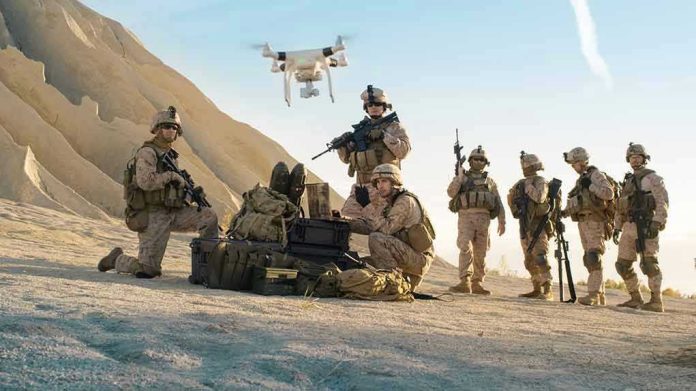
In a move that shocks many Americans, Lithuania is teaching children as young as eight to pilot drones as part of a sweeping national defense plan against Russian threats—raising concerns about youth militarization and the future of civil resistance.
Story Snapshot
- Lithuania launches nine drone training centers, including programs for children as young as eight.
- Over 22,000 citizens, with 7,000 children, will learn drone engineering and piloting by 2028.
- The initiative is a direct response to escalating Russian hybrid warfare and drone incursions.
- Government, defense, and education leaders coordinate to integrate civil resistance and technological training.
Lithuania’s Drone Training Program: Scope and Intent
The Lithuanian government has announced a bold plan to open nine drone training centers over the next three years, aiming to train more than 22,000 citizens—including 7,000 children under the age of 18—in both building and piloting drones. This initiative, which will see its first three centers open in September 2025, is designed as a direct response to increased Russian security threats. By integrating drone technology and operational skills into civil defense, Lithuania seeks to establish a population equipped to counter hybrid warfare tactics, marking a significant escalation in its national security posture.
The program stands out not only for its size but for its inclusion of children as young as eight. Authorities have finalized age-specific curriculums, targeting third- and fourth-grade students alongside high schoolers. The government’s approach transcends traditional STEM education, rooting drone literacy in national defense and civil resistance. This effort is coordinated across the Ministries of Defense and Education, with operational delivery handled by the Lithuanian Riflemen’s Union—a civilian organization known for mobilizing society in support of defense readiness.
Security Context: Russian Hybrid Threats and Baltic Defense
Lithuania, a NATO member bordering Russia’s Kaliningrad and Belarus, faces persistent threats from its eastern neighbors. The country has endured multiple drone incursions, cyberattacks, and disinformation campaigns, with the most recent incident involving an unidentified drone crossing into Lithuanian airspace from Belarus on July 28, 2025. These actions are part of Russia’s ongoing strategy of hybrid warfare in the Baltics, where drone technology has become a frontline tool for both reconnaissance and disruption. Lithuania’s modernization of its defense doctrine reflects a growing recognition of drones as essential to both national security and civil preparedness.
The training centers are a direct answer to these evolving threats. By empowering citizens—including children—to master drone technology, Lithuania aims to build a broad-based, technologically capable population ready for any contingency. The move mirrors Ukraine’s successful mobilization of civilian drone pilots and engineers in its own conflict with Russia, serving as a model for Lithuania’s approach. Funding for the initiative totals €3.3 million, covering equipment and training for all age groups.
Stakeholders and Strategic Collaboration
Key players in this national effort include the Ministries of Defense and Education, the Lithuanian Riflemen’s Union, and the Lithuanian Education Agency. Defense Minister Dovilė Šakalienė has publicly championed the program, emphasizing the importance of expanding civil resistance and technological literacy. Chief of Defense Raimundas Vaikšnoras has advocated for doctrinal updates, prioritizing airspace defense and preemptive interception capabilities. The Riflemen’s Union acts as a bridge between government policy and community mobilization, executing training and fostering civil cohesion.
These stakeholders share a common motivation: to strengthen national security, close gaps in air defense, and integrate defense skills into youth education. Their collaboration ensures unified policy direction, robust funding, and effective implementation across Lithuania. The initiative also boosts the domestic drone engineering and manufacturing sector, with potential spillover effects into commercial applications and innovation.
Impacts, Expert Perspectives, and Controversies
In the short term, the training centers will enhance civil defense readiness, upskill thousands of citizens in drone technology, and increase public engagement in national security. Long-term implications include the creation of a technologically literate, defense-ready population and a potential deterrent effect against Russian aggression. Economically, the program represents a significant investment in infrastructure and equipment, while socially it strengthens civil cohesion and resilience. Politically, Lithuania’s move aligns closely with NATO’s broader defense modernization efforts.
Lithuania wants to teach kids as young as 8 years old how to fly drones to counter Russian threats https://t.co/y26TSsZUa8 pic.twitter.com/6T66yNyurr
— New York Post (@nypost) August 13, 2025
Expert opinions are divided. Security analysts praise mass drone literacy as a strategic asset, while some education specialists warn about the risks of militarizing youth. Defense professionals stress the urgency of adapting to drone warfare, and academic commentators recognize the pioneering blend of STEM and civil defense. Debate continues over how best to balance civil resistance with the risk of escalating regional tensions.
Sources:
Lithuania to teach thousands, including schoolchildren, how to build and pilot drones – Inkl
Flight Risk: Baltics Scramble to Counter Hybrid Drone Threat – CEPA
Ukraine: Lithuania trains 7,000 children to use drones against Russian threat – Adnkronos













